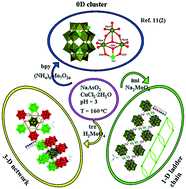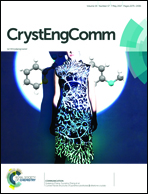Two extended Wells–Dawson arsenomolybdate architectures directed by Na(i) and/or Cu(i) organic complex linkers†
Abstract
Two extended Wells–Dawson arsenomolybdates, (imi)2[{CuI(imi)2}2{Na(imi)2}{AsIIIAs2VMo18O62}]·2H2O (1) and {CuI0.5(trz)}6 [{CuI0.5(trz)}6(As2Mo18O62)] (2), (imi = iminazole; trz = 1,2,3-triazole), are hydrothermally synthesized and extensively characterized. Compounds 1 and 2 contain a fully oxidized Dawson {As2Mo18O62}6− (abbreviated as {As2Mo18}) anion as the parent cluster unit. Compound 1 is a symmetric mono-arsenate capped anion cluster modified by two half occupancy {AsO3} units, which represents a new capping mode for Dawson clusters. The two adjacent mono-arsenate capped structures are linked by two {Na(imi)2} bridges to form a dimeric cluster, which, as a tetra-dentate ligand, further connects with adjacent dimers by four {Cu(imi)2} linkers to form an infinite ladder shaped chain. In compound 2, each classical Dawson cluster links six adjacent analogs by six {Cu0.5(trz)2} fragments forming an unprecedented 3D network via a unique belt-to-belt staggered pattern. This structure can be simplified as a 2,6-connected 3-D framework with {812·123}{8}3 topology. Compounds 1 and 2 represent the first 1-D and 3-D assemblies of Dawson-type arsenomolybdates, respectively. They display unique electrocatalytic behavior for the oxidation of ascorbic acid (AA) and reduction of NO2− as well as good photocatalytic properties for the degradation of the difficult-to-degrade dye AP under UV light.



 Please wait while we load your content...
Please wait while we load your content...